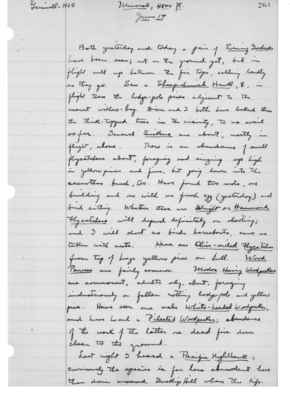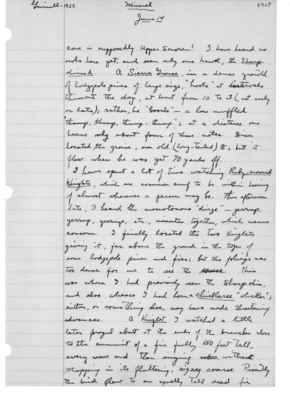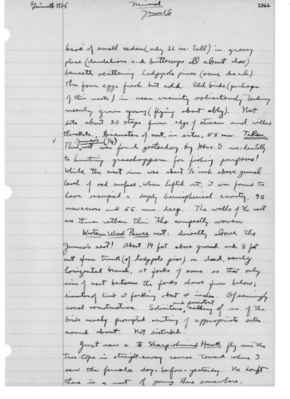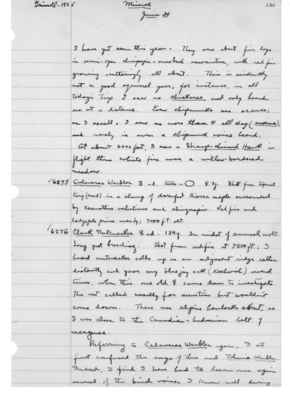Pages That Mention Sharp-shinned Hawk
1925: Joseph Grinnell's field notes
S2 Page 7
Collector: Grinnell - 1925 Location: Lassen Section (Mineral) Date: June 14, 1925 Page Number: 2463
Both yesterday and today a pair of Evening Grosbeaks have been seen; not on the ground yet, but in flight well up between the fir tops, calling loudly as they go. Saw a Sharp-shinned Hawk, female, in flight thru the lodge-pole pines adjacent to the nearest willow-bog. Dixon and I both have looked thru the thick-topped trees in the vicinity, to no avail so far. Several Siskins are about, mostly in flight, above. There is an abundance of small flycatchers about, foraging and singing up high in yellow pines and firs, but going down into the ceanothus bush, too. Have found two nests, one building and one with one fresh egg (yesterday) and bird sitting. Whether these are Wright or Hammond Flycatchers will depend definitely on shooting; and I will shoot no birds hereabouts, save any (?) taken with nests. Hear one Olive-sided Flycatcher from top of huge yellow pine on hill. Wood Pewees are fairly common. Modoc Hairy Woodpeckers are commonest, adults only, about, foraging industriously on fallen rotting lodge-pole and yellow pine. Have seen one male White-headed Woodpecker, and have heard a Pileated Woodpecker; abundance of the work of the latter on dead firs down clean to the ground. Last night I heard a Pacific Nighthawk; curiously this species is far less abundant here than down around Inskip Hill where the life-
S2 Page 8
Collector: Grinnell - 1925 Location: Lassen Section (Mineral) Date: June 14, 1925 Page Number: 2464
zone is supposedly Upper Sonoran! I have heard no owls here yet, and seen only one hawk, the Sharp shinned. A Sierra Grouse, in dense growth of lodgepole pines of large size, "hoots" at intervals thruout the day, at least from 10 to 3 (not early or late); rather, he "boonts" - a low muffled "thump, thump, thump, thump"; at a distance one hears only about four of these notes. Dixon located the grouse, an old (long-tailed) female, but it flew when he was yet 70 yards off. I have spent a lot of time watching Ruby-crowned Kinglets, which are common enuf to be within hearing of almost wherever a person may be. This afternoon late, I heard the monotonous "dinge", yerrup, yerrup, yerrup, etc., minutes together, which means concern. I finally located the two Kinglets giving it, far above in the tops of some lodgepole pines and firs; but the foliage was too dense for me to see the cause. This was where I had previously seen the Sharpshin, and also whence I had hear a chickadee "chicken"; either, or something else, may have made threatening advances. A Kinglet I watched a little later foraged about at the end of branches close to the summit of a fir fully 150 feet tall, every now and then singing without stopping it its fluttering, zigzag course. Presently the bird flew to an equally tall dead fir
S2 Page 10
Collector: Grinnell - 1925 Location: Lassen Section (Mineral) Date: June 15, 1925 Page Number: 2466
base of small cedar (only 32 in. tall) in grassy place (dandelions and buttercups all about also) beneath scattering lodgepole pines (some dead). The four eggs fresh but cold. Old birds (perhaps of this nests) in near vicinity solicitously tending nearly grown young (flying about ably). Nest sits about 20 steps from edge of stream and willow thickets. Diameter of nest, in situ, 55 mm. Taken. This Junco's (1/4) nest was found yesterday by Mrs. G incidentally to hunting grasshoppers for fishing purposes! While the nest rim was about 1/2 inch above general level of sod surface, when lifted out, it was found to have occupied a deeply hemispherical cavity. 90 mm. across and 55 mm. deep. The walls of the nest are thus rather thin this compactly woven. Western Wood Pewee nest: directly above the Junco's nest! About 14 feet above ground and 7 feet out from trunk (of lodgepole pine) on dead, nearly horizontal branch, at forks of same so that only rim of nest between the forks shows from below; diameter of limb at forking about 4 inches. Of seemingly usual construction. Solicitous and persistent calling of one of the birds nearly prompted scrutiny of appropriate sites round about. Not disturbed. Just saw a male Sharp-shinned Hawk fly over the tree-tops in straight-away course toward where I saw the female day-before-yesterday. No doubt there is a nest of young there somewhere.
S2 Page 36
Collector: Grinnell - 1925 Location: Mineral Date: June 22 Page Number: 2490
sheltered within the cavity, the nest being in-set in bark and needle floor right against the charcoal wall. Rim of nest (exposed side) marked by coarse pine twigs and needles, scattering out towards opening of cavity; latter 600 mm. high at peak, 480 mm. wide at base of opening; rim of nest a little higher, about 25 mm., than ground in front. Nest found by watching old birds, with food perching around quietly on stubs of fallen logs and lower branches of big standing trees, finally flying down to side. The yellow thickened corners of mouth and edges of bill loom up a most conspicuous feature of young in shade of cavity. On dry ridge top, open forest of white fir, cedar, yellow and sugar pines.
Saw a Sharp-shinned Hawk in flight from direction of camp, well above tree-tops. One or both of a pair of Evening Grosbeaks were noted repeatedly in a certain section of the woods. Mr. Hoffmann discovered a Hammond(*) Flycatcher's nest^(5500 ft. alt.) fully 90 ft. up on a horizontal sub-branch of a huge sugar pine - of course inaccessible. The birds looked ^at that range and sounded, to me, indistinguishable from the "Wright" Flycatchers I have been getting down here with low brush-built nests. However, only shooting of the birds can settle their identity. I saw one of Hoffman's birds come clear to the ground and flit about in small firs and low snow-brush; yet both of the birds did a lot of foraging fully 100 feet up, in firs and pines.
S2 Page 58
Collector: Grinnell - 1925 Location: Mineral Date: June 30 Page Number: 2511
I have yet seen this year. They were about fir logs in semi-open chinquapin-snowbush association, with red fir growing scatteringly all about. This is evidently not a good squirrel year; for instance, in all today's trip I saw no chickaree, and only heard one at a distance. Even chipmunks are scarce; as I recall, I saw no more than 4 all day (amoenus), and rarely is even a chipmunk voice heard.
At about 6000 feet, I saw a Sharp-shinned Hawk in flight thru the white firs near a willow-bordered meadow.
6275 Calaveras Warbler [male symbol] ad. testes - [testes illustration] 8.3 g, Shot from topmost twig (dead) in a clump of dwarfed Sierra maple surrounded by ceanothus velutinus and chinquapin. Red firs and lodgepole pine nearby; 7000 ft. alt.
6276 Clark Nutcracker [female symbol] ad. 134 g. In midst of annual molt. Long past breeding. Shot from red fir at 7500 ft.: I heard nutcracker calls up on an adjacent ridge rather distantly and gave my bluejay call (Kochwish) several times, when this one old [female symbol] came down to investigate. The rest called nasally for sometime but wouldn't come down. There were alpine hemlocks about, so I was close to the Canadian-hudsonian belt of mergence.
Referring to the Calaveras Warbler again, I at first confused the songs of this and Tolmie Warbler. Indeed, I find I have had to learn over again several of the bird voices I knew well during




